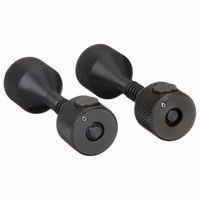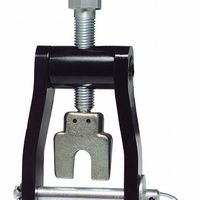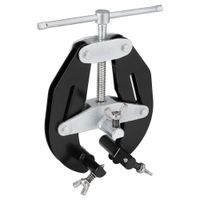Call +(254) 703 030 000 / 751 483 999 / 721 704 777
- Home
- Tools
- Power Tools
- Plumbing Power Tools
- Pipe Alignment Tools Flange Spreaders
.....Read More
Frequently Asked Questions
What are pipe alignment tools used for?
Pipe alignment tools are used to ensure the precise alignment and positioning of pipes during installation, maintenance, or repair processes. These tools are essential in various industries, including construction, plumbing, oil and gas, and manufacturing, where accurate pipe alignment is crucial for system integrity, safety, and efficiency.
The primary purpose of pipe alignment tools is to facilitate the correct orientation and fit-up of pipes before welding or joining. Misalignment can lead to joint failure, leaks, and increased stress on the piping system, which can result in costly repairs and downtime. By using alignment tools, workers can achieve the necessary precision to ensure that pipes are correctly aligned along their axes and at the correct angles.
Common types of pipe alignment tools include pipe clamps, pipe jacks, and pipe fit-up tools. Pipe clamps hold pipes securely in place, preventing movement during the welding or joining process. Pipe jacks support pipes at the desired height and angle, allowing for easy adjustments. Fit-up tools help align the ends of pipes to ensure a seamless connection.
These tools also enhance safety by reducing the risk of accidents associated with manual handling and misalignment. They improve efficiency by minimizing the time and effort required to achieve proper alignment, leading to faster project completion. Additionally, they contribute to the overall quality of the piping system by ensuring that joints are properly aligned, reducing the likelihood of leaks and other issues.
In summary, pipe alignment tools are vital for achieving accurate pipe positioning, ensuring system integrity, enhancing safety, and improving operational efficiency in various industrial applications.
How do flange spreaders work?
Flange spreaders are tools used to separate flanges safely and efficiently, typically in piping systems. They work by applying controlled force to create a gap between two flanges, allowing for maintenance, inspection, or gasket replacement. There are several types of flange spreaders, including mechanical, hydraulic, and wedge-based spreaders.
Mechanical flange spreaders use a screw mechanism to apply force. The tool is inserted between the flanges, and as the screw is turned, it pushes the flanges apart. This type is suitable for smaller flanges and requires manual effort.
Hydraulic flange spreaders use hydraulic pressure to exert force. They consist of a hydraulic cylinder and a pump. The spreader is positioned between the flanges, and hydraulic fluid is pumped into the cylinder, causing it to expand and push the flanges apart. This type is ideal for larger flanges and requires less manual effort.
Wedge-based flange spreaders use a pair of interlocking wedges. The wedges are inserted between the flanges, and as they are driven together, they create a spreading force. This type is versatile and can be used in various flange sizes and conditions.
Flange spreaders are designed to ensure safety and precision. They minimize the risk of damaging the flanges or associated components. Proper use involves selecting the right type and size of spreader, ensuring the tool is correctly positioned, and applying force gradually to avoid sudden movements. Safety precautions, such as wearing protective gear and following manufacturer guidelines, are essential to prevent accidents during the operation.
What is the difference between pipe alignment tools and flange alignment tools?
Pipe alignment tools are used to ensure that pipes are properly aligned during installation or maintenance. These tools help in aligning the pipes along their length and diameter to ensure a straight and even connection, which is crucial for maintaining the integrity of the piping system and preventing leaks. Common pipe alignment tools include pipe clamps, levels, and laser alignment systems.
Flange alignment tools, on the other hand, are specifically designed to align flanges, which are the flat, circular discs at the end of pipes used to connect sections of piping or attach pipes to equipment. Flange alignment tools ensure that the bolt holes of the flanges are perfectly aligned, which is essential for creating a secure and leak-proof seal. These tools often include flange spreaders, alignment pins, and hydraulic flange alignment tools.
In summary, while both types of tools are used to ensure proper alignment in piping systems, pipe alignment tools focus on the overall alignment of the pipe sections, whereas flange alignment tools concentrate on the precise alignment of the flanges for secure connections.
How do you choose the right pipe alignment tool?
To choose the right pipe alignment tool, consider the following factors:
1. **Pipe Size and Material**: Ensure the tool is compatible with the pipe's diameter and material. Different tools are designed for specific sizes and materials like steel, PVC, or copper.
2. **Type of Alignment**: Determine whether you need tools for vertical, horizontal, or angular alignment. Some tools are versatile, while others are specialized.
3. **Precision Requirements**: Assess the level of precision needed. For high-precision tasks, opt for laser alignment tools, which offer greater accuracy.
4. **Environment**: Consider the working environment. For outdoor or harsh conditions, choose durable, weather-resistant tools.
5. **Ease of Use**: Select tools that are user-friendly and require minimal training. This is crucial for efficiency and reducing errors.
6. **Portability**: If the job requires frequent movement, lightweight and portable tools are preferable.
7. **Budget**: Balance cost with functionality. While high-end tools offer advanced features, ensure they fit within your budget.
8. **Brand and Quality**: Opt for reputable brands known for quality and reliability. Check reviews and ratings for user feedback.
9. **Additional Features**: Look for tools with added features like digital displays, built-in levels, or magnetic bases for enhanced functionality.
10. **Safety**: Ensure the tool meets safety standards and includes features that minimize risk during use.
11. **Support and Warranty**: Consider the availability of customer support and warranty options for maintenance and repairs.
By evaluating these factors, you can select a pipe alignment tool that meets your specific needs and ensures efficient and accurate alignment.
What safety precautions should be taken when using flange spreaders?
When using flange spreaders, several safety precautions should be observed to ensure safe and effective operation:
1. **Training and Competence**: Ensure that all operators are adequately trained and competent in using flange spreaders. They should understand the equipment's operation manual and safety guidelines.
2. **Personal Protective Equipment (PPE)**: Wear appropriate PPE, including safety goggles, gloves, hard hats, and steel-toed boots, to protect against potential hazards.
3. **Inspection**: Before use, inspect the flange spreader for any signs of damage, wear, or defects. Check for proper functioning of all components, including hydraulic hoses and connections.
4. **Correct Tool Selection**: Use the right type and size of flange spreader for the specific application. Ensure it is suitable for the flange size and pressure rating.
5. **Work Area Safety**: Keep the work area clean and free of obstructions. Ensure adequate lighting and secure footing to prevent slips and falls.
6. **Load Assessment**: Assess the load and ensure the flange spreader is capable of handling the required force. Do not exceed the tool's rated capacity.
7. **Secure Positioning**: Position the flange spreader correctly and ensure it is stable before applying force. Use additional supports or jacks if necessary to maintain stability.
8. **Controlled Operation**: Apply force gradually and evenly to avoid sudden movements or slippage. Monitor the spreader and flange for any signs of instability or misalignment.
9. **Communication**: Maintain clear communication with all team members involved in the operation. Use hand signals or radios if necessary to coordinate actions.
10. **Emergency Preparedness**: Be prepared for emergencies. Know the location of emergency shut-off controls and first aid kits, and have a plan in place for dealing with accidents or equipment failure.
11. **Post-Operation Checks**: After use, inspect the flange spreader for any damage and perform necessary maintenance. Store the tool properly to prevent damage or unauthorized use.
Can flange alignment tools be used on all types of flanges?
Flange alignment tools are versatile and can be used on a wide range of flange types, but not all. These tools are primarily designed to assist in the alignment of flanges during installation or maintenance to ensure proper sealing and prevent leaks. They are commonly used in industries such as oil and gas, petrochemical, and water treatment.
Flange alignment tools are generally compatible with most standard flange types, including weld neck, slip-on, socket weld, and lap joint flanges. They can handle various sizes and pressure ratings, making them suitable for many applications. However, their effectiveness can be limited by certain factors:
1. **Flange Size and Pressure Rating**: While many tools are adjustable, extremely large or small flanges may require specialized equipment. High-pressure flanges might also need more robust tools to ensure safety and accuracy.
2. **Material and Coating**: Some flanges made from exotic materials or with special coatings may require specific tools to prevent damage during alignment.
3. **Flange Design**: Non-standard or custom-designed flanges, such as those with unique bolt patterns or integrated components, may not be compatible with standard alignment tools.
4. **Environmental Conditions**: In environments with extreme temperatures or corrosive conditions, standard tools may not be suitable, necessitating the use of specially designed equipment.
5. **Tool Limitations**: Some alignment tools are designed for specific flange types or applications, such as those used in subsea operations, which may not be applicable to all flange types.
In summary, while flange alignment tools are adaptable and can be used on many flange types, their use is not universal. It is essential to consider the specific requirements of the flange and the operating environment to select the appropriate tool.
How do you maintain and store pipe alignment tools and flange spreaders?
To maintain and store pipe alignment tools and flange spreaders effectively, follow these steps:
1. **Cleaning**: After each use, clean the tools thoroughly to remove dirt, grease, and debris. Use a mild detergent and water for general cleaning, and ensure all moving parts are free of contaminants.
2. **Inspection**: Regularly inspect the tools for any signs of wear, damage, or corrosion. Check for cracks, bends, or any deformities that could affect performance. Pay special attention to the condition of threads, handles, and alignment surfaces.
3. **Lubrication**: Apply appropriate lubricants to moving parts and joints to ensure smooth operation and prevent rust. Use a high-quality machine oil or grease suitable for the specific materials of the tools.
4. **Calibration**: Periodically calibrate alignment tools to ensure accuracy. Follow the manufacturer's guidelines for calibration procedures and intervals.
5. **Storage**: Store tools in a clean, dry environment to prevent rust and corrosion. Use toolboxes or dedicated storage racks to keep them organized and protected from physical damage. Ensure that tools are stored in a manner that prevents them from falling or being knocked over.
6. **Environmental Control**: Maintain a stable environment with controlled temperature and humidity to prevent material degradation. Avoid exposure to extreme temperatures and moisture.
7. **Inventory Management**: Keep an inventory of all tools, noting their condition and any maintenance performed. This helps in tracking usage and scheduling regular maintenance.
8. **Training**: Ensure that all personnel using the tools are properly trained in their operation and maintenance. This reduces the risk of misuse and extends the lifespan of the tools.
By following these practices, you can ensure the longevity and reliability of pipe alignment tools and flange spreaders.


